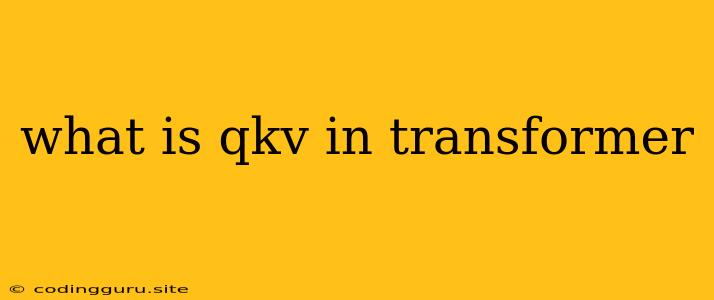What is QKV in Transformer?
Transformers have revolutionized the field of Natural Language Processing (NLP) and have found widespread applications in various machine learning tasks, including machine translation, text summarization, and question answering. A key component within the Transformer architecture is the multi-head attention mechanism, which allows the model to attend to different parts of the input sequence and capture complex relationships between words. Within this attention mechanism lies a crucial concept: QKV, representing Query, Key, and Value.
What is QKV?
QKV stands for Query, Key, and Value, and it forms the foundation of the attention mechanism in Transformer models. To understand QKV, let's break down each component:
Query (Q): The query represents the current word or token that the model is focusing on. It's like asking a question about the relationship between this word and other words in the sequence.
Key (K): The key acts as an identifier for all the other words in the sequence. It provides a unique representation of each word, allowing the model to compare the query to all the other words.
Value (V): The value holds the actual information associated with each word. It's like the answer to the question posed by the query.
How does QKV work in Attention Mechanism?
The attention mechanism utilizes QKV to compute the attention weights, which indicate how much attention the model should pay to each word in the input sequence. Here's the process:
-
Calculate Query, Key, and Value: For each word in the input sequence, the model generates three vectors: query, key, and value.
-
Calculate Attention Scores: The model computes the similarity between the query and each key in the sequence. This similarity is calculated using a dot product between the query and the keys. The resulting values are called attention scores.
-
Normalize Attention Scores: The attention scores are then normalized using the softmax function, resulting in attention weights that sum up to 1. These weights represent the probability of the model attending to each word.
-
Compute Weighted Sum: The attention weights are then used to calculate a weighted sum of the values. This weighted sum represents the context-aware representation of the current word.
What is Multi-Head Attention?
The multi-head attention mechanism is a powerful extension of the basic attention mechanism that allows the model to learn multiple attention patterns simultaneously. It involves performing the QKV process multiple times with different sets of parameters. This enables the model to capture different aspects of the input sequence and learn richer representations.
Why is QKV important?
QKV is crucial for the success of Transformers because it allows the model to:
-
Capture long-range dependencies: The attention mechanism enables the model to consider the context of distant words in the sequence, which is essential for understanding the meaning of sentences and paragraphs.
-
Learn complex relationships: By computing attention weights, the model can identify the most relevant words in the sequence and learn complex relationships between words.
-
Improve performance: The use of QKV in the attention mechanism has significantly improved the performance of Transformer models across various NLP tasks.
Conclusion
QKV is a fundamental concept in the Transformer architecture that enables the model to attend to different parts of the input sequence and capture complex relationships between words. The query, key, and value components work together in the attention mechanism to compute attention weights and generate context-aware representations, allowing the model to learn richer representations and achieve state-of-the-art results on NLP tasks. Understanding QKV is essential for comprehending the inner workings of Transformer models and harnessing their power in various NLP applications.
